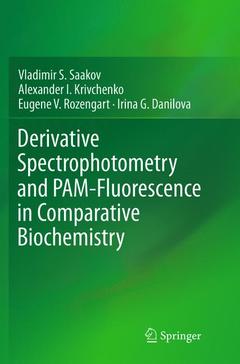Description
Derivative Spectrophotometry and PAM-Fluorescence in Comparative Biochemistry, 1st ed. 2015
Authors: Saakov Vladimir S., Krivchenko Alexander I., Rozengart Eugene V., Danilova Irina G.
Language: English
Subjects for Derivative Spectrophotometry and PAM-Fluorescence in...:
Approximative price 158.24 €
In Print (Delivery period: 15 days).
Add to cartPublication date: 03-2019
611 p. · 15.5x23.5 cm · Paperback
Approximative price 158.24 €
In Print (Delivery period: 15 days).
Add to cartPublication date: 12-2015
611 p. · 15.5x23.5 cm · Hardback
Description
/li>Contents
/li>Comment
/li>
This book presents various examples of how advanced fluorescence and spectroscopic analytical methods can be used in combination with computer data processing to address different biochemical questions. The main focus is on evolutionary biochemistry and the description of biochemical and metabolic issues; specifically, the use of pulse amplitude modulated fluorescence (PAM) for the functional analysis of the cellular state, as well as results obtained by means of the derivative spectroscopy method characterizing structural reorganization of a cell under the influence of external factors, are discussed. The topics presented here will be of interest to biologists, geneticists, biophysicists and biochemists, as well as experts in analytical chemistry, pharmaceutical chemistry and radio chemistry and radio activation studies with protonen and alpha-particles. It also offers a valuable resource for advanced undergraduate and graduate students in biological, physical and chemical disciplines whose work involves derivative spectrophotometry and PAM-fluorescence.
Introduction. Development of the methodological base, disputes, conclusions.- Successes of the pulse amplitude modulated fluorescence application: Fluorescence spectroscopy in amino acid analysis.- Theory of energetic bases of the green cells resistance to abiotic environmental factors.- Methodological approaches in our experimental work: The Main Law of Light Absorption by a Substance.- Correctness and Accuracy of Spectrophotometric Data.- Basis of Derivative Spectrophotometry.- Application of the ORIGIN package for processing of numerical spectra of biologically active substances and native structures.- New approaches for determination of oxygen isotopes in biochemical works.- Application of Derivative Spectrophotometry in Comparative Biochemical Studies: Analytical significance of derivative spectrophotometry in comparative studies of amino acids and proteins.- The derivative spectrophotometry for analysis of a number of guanidine preparations.- The proof of polycomponent composition of the promising antitumor drug “Ukrain”.- Derived spectra application for the analysis of derived forms of nondepolarizing muscle relaxant tercuronium, of vitamins and hormones.- The Range of DHSO Application in Experiments with Pigments of Plants and Animals: New data on derived spectra of high orders for some carotenoids.- Neoxanthin as a probable key product of formation of α- and β- carotenoid derivatives.- Metabolic transformations of labeled 14C- or 3H- carotene in animal tissues.- Importance of the derivative spectrophotometry for study of alternative ways of carotenoids biosynthesis in Procaryota and Eucaryota.- Possibility of participation of α-ketoglutaric acid funds in carotenoids biosynthesis in chloroplasts.- Malic acid as the source for carotenoids synthesis in plants with С4-way of carbon in photosynthesis.- Indication of the de-epoxidation reaction with help of derived spectra.- Conclusion.
Introduces new concepts for the use of derivative spectrophotometry and PAM-fluorescence
Discusses the topic in an interdisciplinary light, bridging the gap between physics, biochemistry, cell biology and genetics
Provides a critical literature survey and new perspectives to the topic
Includes supplementary material: sn.pub/extras




